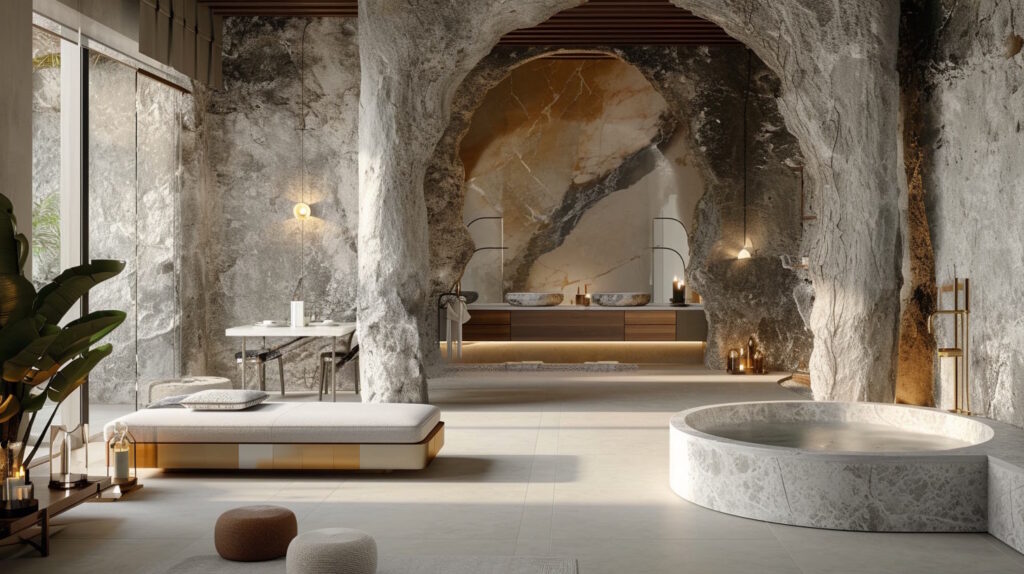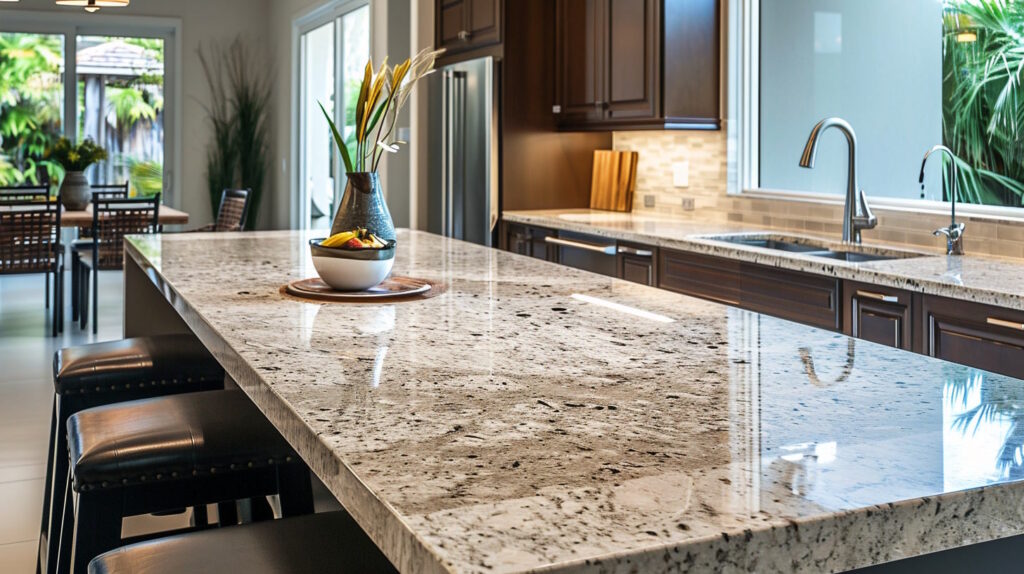The realm of architecture and design has long been enchanted by the allure of stone. A material steeped in history and versatility, stone’s resurgence in modern design is a testament to its enduring appeal. In this exploration, we delve into how various cultures across the globe are redefining and embracing stone trends, giving life to both traditional and innovative expressions in architecture and design.
The Growing Popularity of Stone in Architecture and Design
Globally, stone is experiencing a renaissance as architects and designers revisit this ancient material. Its natural beauty, durability, and ecological benefits are just a few reasons behind its growing popularity. From sleek marble countertops to rustic limestone walls, stone is being used in myriad ways to create aesthetic and functional spaces. This revival is not just a nod to the past but a bold step into the future, as new technologies and creative approaches open up endless possibilities in stone craftsmanship.
Cultural Significance of Stone
Stone holds a unique place in the history and culture of many regions. It’s not just a building material but a medium through which stories, traditions, and artistic expressions are passed down through generations. This section will delve into the deep-rooted cultural significance of stone and how it continues to influence contemporary design. In various parts of the world, stone is more than just the sum of its physical properties; it embodies a cultural heritage, symbolizing strength, permanence, and a connection to the earth. From the majestic pyramids of Egypt to the intricate stonework of Gothic cathedrals, stone has been an integral part of human civilization, shaping our environments and reflecting our artistic aspirations.
In this article, we journey through different continents, uncovering the unique ways in which stone is being used. We’ll see how local resources, cultural heritage, and contemporary trends converge to create distinctive stone applications that are both innovative and respectful of tradition. So, let’s embark on this global tour of stone trends, discovering the materials, designs, and cultural influences that make stone an ever-evolving and fascinating element in the world of architecture and design.

Stone Trends in Europe
Europe’s architectural landscape is a vivid tapestry of stone structures, each narrating a story of the continent’s rich history and evolving aesthetic preferences. In this section, we explore how stone, as a quintessential element, has shaped European architecture and continues to influence modern design trends.
Classic and Modern Stone Choices
In Europe, the use of stone is a harmonious blend of tradition and modernity. Classic stones like granite, marble, and limestone have been the cornerstones of European architecture for centuries. These materials, known for their durability and timeless beauty, are still widely used in both restoration projects and new constructions. However, there’s a growing trend towards incorporating modern stones and innovative applications. Designers are experimenting with less conventional stones like basalt and sandstone, utilizing them in contemporary ways to create striking contrasts with traditional aesthetics. This fusion of old and new is not only a testament to the versatility of stone but also reflects Europe’s ongoing dialogue between its rich past and dynamic present.
European Landmarks Influencing Stone Trends
The architectural heritage of Europe has a profound impact on contemporary stone trends. Landmarks such as the Colosseum in Rome, the Gothic cathedrals of France, and the Baroque palaces of Vienna serve as enduring sources of inspiration. These iconic structures showcase the versatility of stone and its ability to convey power, elegance, and artistry. Modern architects and designers often draw from these historical masterpieces, incorporating elements of their stone workmanship into current designs. For instance, the use of intricately carved stone in modern luxury homes can be traced back to the grandeur of Renaissance architecture. Similarly, the minimalist and sleek stone surfaces in contemporary buildings echo the refined masonry of Classical antiquity. This ongoing influence underscores how European landmarks continue to shape the narrative of stone trends across the continent.
In summary, stone trends in Europe are a captivating mix of historical reverence and contemporary innovation. The continent’s architectural legacy, enriched by centuries of craftsmanship and artistic expression, continues to guide and inspire the use of stone in modern design. This enduring relationship between old and new not only preserves Europe’s cultural heritage but also drives the evolution of stone as a fundamental and expressive element in architecture and design.
Asian Influence on Stone Trends
Asia’s diverse cultural and historical landscape offers a unique and rich perspective on stone usage. This vast region, with its myriad traditions and evolving styles, plays a pivotal role in shaping contemporary stone trends. Here, we delve into how Asia’s legacy and modern advancements in stone design are influencing global architecture and interior design.
Traditional Asian Stone Uses
The traditional use of stone in Asia is deeply rooted in its history, serving not just as a building material but as a medium for artistic and spiritual expression. In countries like China, Japan, and India, stone has been an integral part of architectural marvels for millennia. The Great Wall of China, a symbol of resilience and strength, showcases the strategic use of stone in ancient construction. Temples and palaces across India demonstrate intricate stone carvings that depict religious and cultural narratives. Japanese Zen gardens use stones to symbolize various natural elements, reflecting the deep connection between nature and spiritual well-being. These historical examples highlight the importance of stone in Asian cultures, not only for its functionality but for its ability to convey deeper meanings and connect with the spiritual and natural world.
Modern Innovations in Asian Stone Design
In recent years, Asia has been at the forefront of innovation in stone design and architecture. Countries like Singapore, Japan, and South Korea are pushing the boundaries of how stone can be used in urban and interior design. The emphasis is on blending traditional techniques with modern technology, creating unique and sustainable stone applications. For instance, lightweight stone veneers and digitally-cut stone patterns are becoming increasingly popular in contemporary Asian architecture, offering new ways to incorporate stone’s natural beauty into modern settings. These innovations also reflect a growing environmental consciousness, with an emphasis on sustainable sourcing and minimizing waste during the stone production process.
Asian influence on stone trends is a testament to the region’s ability to harmonize its rich heritage with cutting-edge innovation. The traditional and modern uses of stone in Asia provide a broad spectrum of inspiration, from the spiritually significant stone structures of the past to the technologically advanced and sustainable designs of the present. This fusion is a powerful force in the global stone industry, influencing trends and practices far beyond Asia’s borders.
North American Stone Trends
North America, with its diverse landscapes and cultural history, exhibits a unique approach to stone trends in architecture and design. This section explores how indigenous traditions and contemporary influences intertwine to shape the region’s use of stone, reflecting both its rich heritage and modern sensibilities.
Indigenous and Contemporary Stone Usage
The use of stone in North America has deep roots in the continent’s indigenous cultures. Native American and First Nations peoples have long utilized local stones for constructing dwellings, creating tools, and carving totems that carry cultural and spiritual significance. These practices highlight a profound respect for natural materials and their integration into daily life. In contemporary architecture, this reverence for stone is echoed in the use of regional materials that reflect the landscape and cultural context. Designers and architects draw inspiration from indigenous practices, using stone not only for its functionality but also as a means to connect with the land and honor local traditions.
In modern settings, North American stone trends are characterized by a blend of innovation and sustainability. There is an increasing focus on eco-friendly practices, such as using locally-sourced stone to reduce transportation emissions and choosing reclaimed or recycled stone materials. This shift is part of a broader trend towards sustainable design, where stone is valued for its durability and minimal environmental impact.
Eco-Friendly Stone Trends in North America
Sustainability is a driving force behind current stone trends in North America. Architects and designers are increasingly mindful of the environmental impact of their materials, leading to a rise in the use of sustainable stone options. This includes the use of reclaimed stone from old buildings or remnants from other projects, reducing waste and the need for new quarrying. Additionally, there is a growing interest in using local stone varieties, which not only lowers transportation emissions but also helps projects blend seamlessly with their natural surroundings. This approach aligns with a broader movement towards green architecture, where the choice of materials is as important as the design itself.
In conclusion, North American stone trends are a reflection of the continent’s diverse cultural heritage and its commitment to sustainability. The thoughtful use of stone, drawing from indigenous traditions and contemporary eco-friendly practices, showcases a deep connection to the environment and a forward-thinking approach to design. As these trends continue to evolve, they contribute significantly to the global dialogue on sustainable architecture and the responsible use of natural resources.
Stone Trends in the Middle East and Africa
The Middle East and Africa, regions rich in history and natural resources, offer a unique perspective on stone trends. These areas are not only steeped in ancient traditions of stone craftsmanship but are also embracing modern techniques and designs. This section explores the dynamic and diverse ways in which stone is used in these regions, reflecting both their historical significance and contemporary innovation.
Historical Significance and Modern Adaptations
In the Middle East and Africa, stone has been a fundamental part of architecture and art for thousands of years. The pyramids of Egypt, Petra in Jordan, and the ancient cities of Mesopotamia are testaments to the historical mastery of stone workmanship. These structures not only display the durability and versatility of stone but also its ability to convey power and beauty. In modern times, this rich heritage continues to influence stone trends. Contemporary architects and designers in these regions draw inspiration from historical techniques, adapting them to modern contexts. This fusion of old and new is evident in the use of traditional stone carving methods in modern buildings, as well as the incorporation of local stone materials in innovative architectural designs.
Unique Stone Types and Their Cultural Impact
The Middle East and Africa are home to a variety of unique stone types, each with its own cultural and historical significance. In the Middle East, limestone and marble have been used for centuries and continue to be popular in modern construction. These materials are often chosen for their aesthetic appeal and durability, lending a sense of timelessness to buildings. In Africa, soapstone, granite, and slate are commonly used, reflecting the continent’s diverse geological makeup. These stones are not just used for structural purposes but are also integral to artistic expressions, such as sculptures and decorative elements. The choice of stone in these regions is often deeply connected to cultural identity, with certain types holding symbolic or historical significance.
The stone trends in the Middle East and Africa are a rich tapestry of history, culture, and innovation. These regions showcase how traditional practices can be harmoniously blended with modern techniques, resulting in unique and inspiring architectural designs. As we continue to witness the evolution of stone trends in these areas, they offer valuable insights into the sustainable and creative use of natural resources in architecture and design.
Global Stone Trends in Interior Design
The use of stone in interior design has transcended from being a mere structural element to a symbol of sophistication and a canvas for creative expression. Around the world, interior designers are leveraging the versatility of stone to elevate spaces with both aesthetic and functional appeal. This section delves into the innovative ways stone is being utilized in interior design globally, reflecting a blend of cultural influences, technological advancements, and sustainability considerations.
Innovative Use of Stone in Interiors
In the realm of interior design, stone is being used in inventive ways that go beyond traditional countertops and flooring. Designers are experimenting with different types of stone to create unique textures, patterns, and color palettes. For instance, thin stone veneers are gaining popularity for their flexibility and lightweight nature, allowing for applications in areas where traditional stone might be impractical. Backlit onyx walls, marble accent pieces, and pebble mosaics are some of the creative ways stone is being used to add a touch of luxury and uniqueness to interiors.
Stone as a Functional and Aesthetic Element
Stone is not just chosen for its beauty; its functional attributes make it a preferred material in various aspects of interior design. Its durability and ease of maintenance are key factors for its use in high-traffic areas like kitchens and bathrooms. Natural stone also offers thermal mass, helping regulate indoor temperatures and contributing to energy efficiency. Furthermore, the use of stone in interiors is being seen as a way to bring nature indoors, creating a sense of tranquility and connection to the outdoors. This biophilic approach to design, where natural elements are integrated into built environments, is a growing trend that underscores the relevance of stone in modern interior design.
The global trends in stone usage within interior design showcase the material’s timeless appeal and adaptability. From traditional applications to innovative expressions, stone continues to be a favored choice among designers looking to blend functionality with aesthetic beauty. As these trends evolve, they reflect a broader narrative of sustainability, innovation, and the human desire to connect with the natural world through our living spaces.
Conclusion
The exploration of global stone trends reveals a fascinating intersection of history, culture, and innovation. From the ancient structures of the Middle East and Africa to the modern architectural marvels in Europe, Asia, and North America, stone remains a pivotal and versatile material in both construction and design. Its enduring presence in architecture and interior design speaks to its timeless beauty, durability, and inherent connection to the natural world.
The resurgence of stone in contemporary design is not just a revival of traditional practices but a forward-looking movement that embraces new technologies and sustainable practices. Whether it’s the incorporation of local stone varieties in North America, the fusion of ancient and modern techniques in Asia, or the eco-friendly trends in Europe, each region brings its unique perspective and innovation to the global narrative of stone trends.
As we move forward, the use of stone is likely to be influenced further by environmental considerations, technological advancements, and a deepening appreciation for cultural heritage. The versatility of stone, coupled with a growing focus on sustainability, ensures its continued relevance in the architectural and design landscapes of the future.
In conclusion, the global trends in stone usage not only highlight the material’s aesthetic and functional qualities but also its ability to adapt, inspire, and tell the story of human civilization. As architects, designers, and consumers continue to explore the potential of stone, it remains a fundamental element that bridges the past with the present, and the natural with the built environment, in our continuous quest for beauty, functionality, and harmony.
Frequently Asked Questions (FAQs)
- How is the use of stone in architecture evolving with modern technology?
The use of stone in architecture is evolving significantly with advancements in technology. Cutting-edge techniques like digital cutting and 3D printing are allowing for more intricate and precise designs, while innovations in stone veneer technology enable more versatile and lightweight applications. - What are some popular types of stone used in contemporary interior design?
Popular stones in contemporary interior design include marble, granite, quartz, and onyx. Designers are also exploring less conventional options like travertine, limestone, and soapstone for their unique textures and colors. - How are sustainability considerations impacting stone trends in architecture?
Sustainability considerations are leading to the increased use of locally sourced stones, recycling of stone materials, and adoption of eco-friendly quarrying practices. These practices reduce environmental impact and promote the use of stone as a sustainable building material. - What role does cultural heritage play in stone trends around the world?
Cultural heritage plays a significant role in stone trends, with many regions drawing on historical practices, local materials, and traditional designs. This results in a rich diversity of stone applications that reflect the cultural identity and history of each area. - Can stone be considered an eco-friendly material in construction and design?
Yes, stone can be considered eco-friendly due to its durability, low maintenance, and the availability of sustainable sourcing options. Its thermal mass properties also contribute to energy efficiency in buildings. - What future trends can we expect in the use of stone in architecture and design?
Future trends in stone usage may include more innovative and sustainable applications, the integration of smart technologies, and a continued focus on blending traditional craftsmanship with modern design practices.





